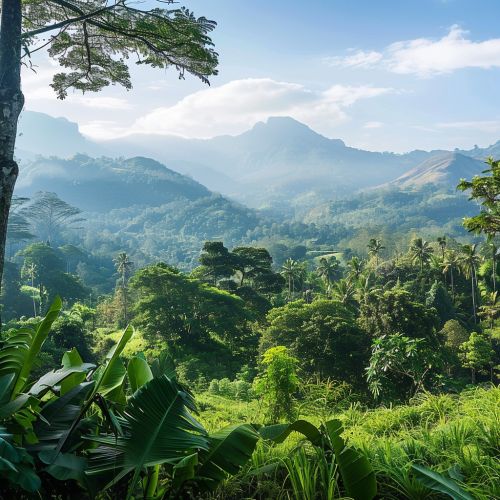Sri Lanka
Geography and Climate
Sri Lanka, an island nation in the Indian Ocean, is located to the southeast of the Indian subcontinent. It is separated from India by the Palk Strait and the Gulf of Mannar. The island covers an area of approximately 65,610 square kilometers, making it the 25th largest island in the world. The topography of Sri Lanka is diverse, featuring coastal plains, central highlands, and a mountainous region in the south-central part of the island.


The climate of Sri Lanka is tropical and influenced by monsoons. The southwest monsoon, which occurs from May to September, brings heavy rainfall to the southwestern part of the island. The northeast monsoon, from December to February, affects the northeastern regions. The central highlands experience a cooler climate due to their elevation, while the coastal areas remain warm and humid throughout the year.
History
Ancient and Medieval Periods
Sri Lanka's history dates back to ancient times, with evidence of human settlements dating back to the Paleolithic era. The island was known as Lanka in ancient Indian texts and was later referred to as Ceylon during the colonial period. The earliest known civilization in Sri Lanka was the Anuradhapura Kingdom, which emerged around the 4th century BCE. Anuradhapura served as the capital and a major center of Buddhism until the 10th century CE.
The Polonnaruwa Kingdom succeeded Anuradhapura and became the island's capital in the 11th century. This period saw significant advancements in irrigation, architecture, and art. The kingdom eventually declined due to invasions and internal conflicts, leading to the rise of the Kandy Kingdom in the central highlands.
Colonial Era
The colonial era began with the arrival of the Portuguese in 1505, followed by the Dutch in 1658, and finally the British in 1796. The British established control over the entire island by 1815, making it a crown colony. During British rule, significant changes occurred in the island's economy, infrastructure, and social structure. The introduction of plantation agriculture, particularly tea, rubber, and coconut, transformed Sri Lanka's economy.
Demographics
Sri Lanka has a diverse population of approximately 21 million people. The majority ethnic group is the Sinhalese, who make up about 74% of the population. The Tamils, both Sri Lankan and Indian, constitute around 15%, while the Moors, a Muslim ethnic group, account for about 9%. Other minority groups include the Burghers, Malays, and Veddas, the indigenous people of Sri Lanka.
The official languages are Sinhala and Tamil, with English widely used for official and commercial purposes. Buddhism is the predominant religion, practiced by about 70% of the population, followed by Hinduism, Islam, and Christianity.
Economy
Sri Lanka's economy is classified as a developing economy with a focus on agriculture, manufacturing, and services. The country is one of the world's largest producers of tea, and the tea industry remains a significant contributor to the economy. Other important agricultural products include rubber, coconut, and spices.
The manufacturing sector includes textiles and garments, which are major export items. The services sector, particularly tourism, has grown rapidly in recent years, contributing significantly to the country's GDP. Sri Lanka's strategic location along major shipping routes has also made it an important hub for maritime trade.
Culture
Sri Lankan culture is a rich tapestry of influences from its diverse ethnic groups and historical interactions with other civilizations. The island's cultural heritage is deeply rooted in Buddhism, which has shaped its art, architecture, and festivals. Notable cultural landmarks include the ancient cities of Anuradhapura and Polonnaruwa, the Sigiriya rock fortress, and the Temple of the Tooth in Kandy.
Traditional music, dance, and drama play a vital role in Sri Lankan culture. The Kandyan dance is a classical dance form that originated in the central highlands, while the Low Country dances are popular in the coastal regions. Sri Lankan cuisine is known for its use of spices, with rice and curry being the staple dish.
Politics and Government
Sri Lanka is a democratic socialist republic with a presidential system of government. The President is the head of state, head of government, and commander-in-chief of the armed forces. The Parliament is a unicameral legislature with 225 members elected for a five-year term.
The country has experienced significant political changes since gaining independence from Britain in 1948. The Sri Lankan Civil War, which lasted from 1983 to 2009, had a profound impact on the nation's political landscape. The war ended with the defeat of the Liberation Tigers of Tamil Eelam (LTTE), but issues related to ethnic reconciliation and political reform remain ongoing.
Education and Health
Sri Lanka has a well-established education system, with free education provided by the government from primary to tertiary levels. The literacy rate is one of the highest in South Asia, reflecting the country's emphasis on education. Major universities include the University of Colombo, University of Peradeniya, and University of Sri Jayewardenepura.
The healthcare system in Sri Lanka is a mix of public and private services. The government provides free healthcare through a network of hospitals and clinics. The country has made significant progress in improving health indicators, such as life expectancy and maternal and child health.
